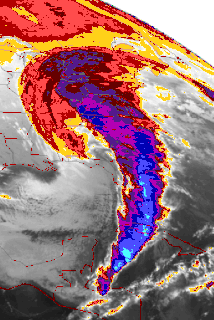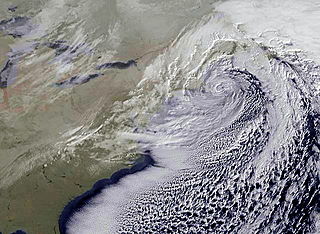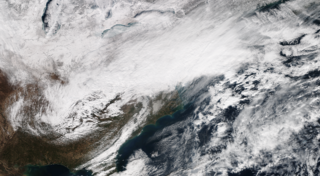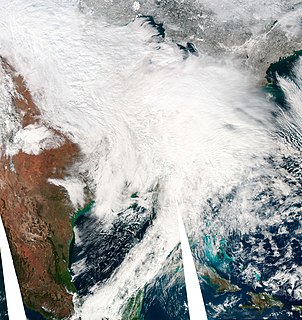
A blizzard is a severe snowstorm characterized by strong sustained winds of at least 56 km/h (35 mph) and lasting for a prolonged period of time—typically three hours or more. A ground blizzard is a weather condition where snow is not falling but loose snow on the ground is lifted and blown by strong winds. Blizzards can have an immense size and usually stretch to hundreds or thousands of kilometres.

The 1993 Storm of the Century was a large cyclonic storm that formed over the Gulf of Mexico on March 12, 1993. The storm was unique and notable for its intensity, massive size, and wide-reaching effects; at its height, the storm stretched from Canada to Honduras. The cyclone moved through the Gulf of Mexico and then through the eastern United States before moving on to eastern Canada. The storm eventually dissipated in the North Atlantic Ocean on March 15.

The December 2010 North American blizzard was a major nor'easter and historic blizzard affecting the Contiguous United States and portions of Canada from December 22–29, 2010. From January 4–15, the system was known as Windstorm Benjamin in Europe. It was the first significant winter storm of the 2010–11 North American winter storm season and the fifth North American blizzard of 2010. The storm system affected the northeast megalopolis, which includes major cities such as Norfolk, Philadelphia, Newark, New York City, Hartford, Providence, and Boston. It brought between 12 and 32 inches of snow in many of these areas.

The 2015–16 North American winter was not as frigid across North America and the United States as compared to the 2013–14 and 2014–15 winters. This was mainly due to a strong El Niño, which caused generally warmer-then-average conditions. However, despite the warmth, significant weather systems still occurred, including a snowstorm and flash flooding in Texas at the end of December and a large tornado outbreak at the end of February. The main event of the winter season, by far and large, was when a crippling and historic blizzard struck the Northeast in late January, dumping up to 3 feet of snow in and around the metropolitan areas.

The February 14–15, 2015 North American blizzard was a potent blizzard occurred in the Northeast United States. The storm dropped up to 25 inches (64 cm) of snow in the regions already hit hard with snow from the past 2 weeks. The storm system also brought some of the most coldest temperatures to the Northeast in its wake.

The February 2016 North American winter storm was a strong winter storm that caused more than 70,000 people in southern California to lose their electricity, with many broken trees and electrical lines in that area, with the Southern Rocky Mountains having the potential to receive some of the greatest snowfall from the system. One person in San Diego, California area died when a tree fell on their car. Another person in Minnesota died after being struck by a car while crossing a street.

The January 20–22, 2014 North American blizzard was a fast-moving but disruptive blizzard that moved through the Northeast, mainly the Mid-Atlantic states, dumping up to 1 foot (30 cm) in areas around the New York City area. The storm also brought cold temperatures behind it, similar to a snowstorm earlier that month.

The January 31 – February 2, 2015 North American blizzard was a major winter storm that plowed through the majority of the United States, dumping as much as 2 feet (24 in) of new snowfall across a path from Iowa to New England, as well as blizzard conditions in early February 2015. It came less than a week after another crippling blizzard which impacted the Northeast with 2–3 feet of snow. It was the first of many intense winter storms to occur in the nation during the month of February, partly in due to an ongoing cold wave that was beginning to take shape shortly after the storm subsided.

The 2012–13 North American winter started out somewhat early, as the remnants of Hurricane Sandy brought heavy snow to the mountains of West Virginia in late October. Later, a strong nor'easter affected the weary Northeast, hampering storm recovery efforts and dropping several inches of snow. The rest of the winter featured several other notable events, such as a Christmas winter storm that affected most of the eastern part of the country, and the most notable event occurring in early February, when a powerful blizzard struck the Northeast and bringing record snow to some areas. During the winter, a weak El Nino was expected to influence weather conditions across the continent.

The 2009–10 North American winter saw several major blizzards.

The 2010–11 North American winter was influenced by an ongoing La Niña, seeing winter storms and very cold temperatures affect a large portion of the continental United States, even as far south as the Texas Panhandle. Notable events included a major blizzard that struck the Northeastern United States in late December with up to 2 feet (24 in) of snowfall and a significant tornado outbreak on New Year's Eve in the southern United States. By far the most notable event was a historic blizzard that impacted areas from Oklahoma to Michigan in early February which broke numerous snowfall records, and one of the few winter storms to rank as a Category 5 on the Regional Snowfall Index.

The 2016–17 North American winter was quite warm across North America in general, due in part to a weak La Niña that was expected to influence weather conditions across the continent. Several notable events occurred during the season, including a potent winter storm that affected the East Coast of the United States in early January, the second-largest winter tornado outbreak on record later that month, and an unusually warm February. In addition, towards the end of the season, a large cyclonic storm system that caused a large tornado outbreak, flooding, and a potent blizzard in the heart of the country. However, the most notable event of the winter was a powerful blizzard that impacted the Northeast and New England in mid-March, towards the end of the season.

The February 9–11, 2017 North American blizzard was a fast-moving but powerful blizzard that affected the Northeastern United States with winter weather in the time span of February 8–9. Forming as an Alberta clipper in the northern United States, the system initially produced light snowfall from the Midwest to the Ohio Valley as it tracked southeastwards. It eventually reached the East Coast of the United States and began to rapidly grow into a powerful nor'easter. Up to 18 inches (46 cm) of snow as well as blizzard conditions were recorded in some of the hardest hit areas before the system moved away from the coastline early on February 10.

The 2017–18 North American winter saw weather patterns across North America that were very active, erratic, and protracted, especially near the end of the season, resulting in widespread snow and cold across the continent during the winter. Significant events included rare snowfall in the South, an outbreak of frigid temperatures that affected the United States during the final week of 2017 and early weeks of January, and a series of strong nor'easters that affected the Northeastern U.S during the month of March. In addition, flooding also took place during the month of February in the Central United States. Finally the winter came to a conclusion with a powerful storm system that caused a tornado outbreak and blizzard in mid-April. The most intense event, however, was an extremely powerful cyclonic blizzard that impacted the northeastern United States in the first week of 2018. Similar to the previous winter, a La Niña was expected to influence the winter weather across North America.

The January 2018 North American blizzard was a powerful cyclonic blizzard that caused severe disruption along the East Coast of the United States and Canada in early January 2018. The storm dropped up to 2 feet of snow in the Mid-Atlantic states, New England, and Atlantic Canada, while areas as far south as southern Georgia and far northern Florida had brief wintry precipitation, with 0.1 inches of snow measured officially in Tallahassee, Florida.
The January 2019 North American winter storm was a long-lived winter storm, forming as a large area of low pressure off the Pacific Northwest shoreline January 16, making its way to the Northeast by January 21. Its effects included heavy rain/high elevation snow and gusty winds in California, severe weather in the south, near-blizzard conditions in Upstate New York, an ice storm in New England and minor coastal flooding in the Mid-Atlantic.

The 2019–20 North American winter was unusually warm for many parts of the United States; in many areas, neutral ENSO conditions controlled the weather patterns, resulting in the sixth-warmest winter on record, and many areas in the Northeast saw one of the least snowiest winters in years. Some notable events still occurred, such as a powerful blizzard that impacted the Western United States in late November, a series of cold shots in January and February, a snowstorm within the Texas Panhandle and a late-season blizzard in the High Plains.

The 2020–21 North American winter was the most significant winter season to affect North America in several years, and the costliest on record, with a damage total of at least $197 billion. The season featured 6 storms ranking on the Regional Snowfall Index scale, with 4 storms ranking as at least a Category 3. Most of the winter's damage and fatalities occurred due to a historic and major cold wave in mid-February. Several other significant events occurred, including a crippling early-season ice storm in the Southern Plains, a powerful nor'easter in mid-December, another major nor'easter in early February, two major and widespread winter storms in mid-February, and a major blizzard in the Rocky Mountains in mid-March. The winter-related events were responsible for at least 235 fatalities, making it the deadliest winter in several years. A La Niña pattern influenced much of the winter in North America.

February 2021 North American winter storm can refer to any of six significant winter storms that impacted North America in February 2021:

The February 12–14, 2017 North American blizzard was a strong and historic nor'easter that affected the Northeastern United States and Eastern Canada from February 12–14. It impacted the Northeastern United States less than a week after the February 9–11, 2017 North American blizzard. This blizzard was more localized and less widespread than the previous storm, but snow totals were higher in some areas, including portions of Maine and Vermont. The system caused 2 fatalities and is estimated to have caused over $3.9 million in damages. It was unofficially named Winter Storm Orson by The Weather Channel.


















